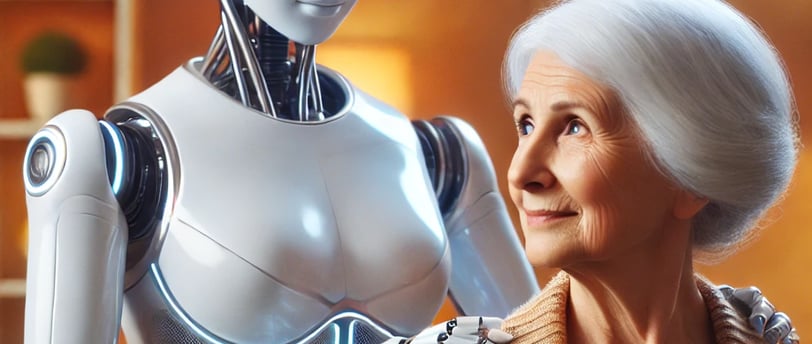AI Woman v. Regular Robot
Emotionally intelligent AI Woman
3/12/20254 min read


Beyond Circuits and Code: The Profound Difference Between Emotionally Intelligent AI and Traditional Robots 🤖❤️
In the rapidly evolving landscape of artificial intelligence and robotics, we're witnessing the emergence of two distinct technological approaches: traditional robots programmed for functional tasks and emotionally intelligent AI systems designed for human-centered interaction. The differences between these technologies extend far beyond mere technical specifications—they represent fundamentally different philosophies about the relationship between humans and machines.
The Traditional Robot: Function Over Feeling 🔧
For decades, robotics has focused primarily on creating machines that can perform specific physical or computational tasks with precision, speed, and reliability:
Task-Oriented Design ⚙️
Traditional robots are built around clearly defined functions:
Industrial robots programmed to perform the same manufacturing task thousands of times
Service robots designed to vacuum floors or deliver items in hospitals
Data-processing systems that execute specific analytical functions
Rules-Based Programming 📋
Conventional robots operate through explicit programming with:
Predefined responses to specific inputs
Binary decision trees with clear yes/no pathways
Limited ability to adapt beyond their programming
Focus on achieving measurable, objective outcomes
Interaction Limitations 🚫
When traditional robots interact with humans, the experience is often:
Transactional rather than relational
Characterized by rigid command-response patterns
Lacking contextual awareness or memory of past interactions
Unable to recognize or respond to emotional states
The classic robot exemplifies a tool-based approach to technology—highly valuable for specific applications but fundamentally limited in its ability to engage with the full spectrum of human experience.
Emotionally Intelligent AI: Connection Through Understanding 💫
In contrast, emotionally intelligent AI represents a paradigm shift toward systems designed specifically to understand and engage with human emotions, preferences, and needs:
Human-Centered Design 👥
These advanced systems are built around human experience:
Designed to recognize and respond appropriately to emotional cues
Architected to build relationships rather than just execute tasks
Focused on supporting wellbeing and quality of life
Developed with empathy and connection as core design principles
Adaptive Learning Systems 🧠
Unlike rule-based robots, emotionally intelligent AI operates through:
Sophisticated machine learning that evolves through interaction
Natural language processing that understands context and nuance
Recognition of emotional patterns across verbal and non-verbal cues
Continuous adaptation to individual preferences and needs
Relationship-Building Capabilities 🌱
Interactions with emotionally intelligent AI are characterized by:
Conversational flow that feels natural and reciprocal
Memory that creates continuity across interactions
Responsiveness to emotional states and needs
Ability to provide appropriate emotional support
The Experience Difference: Interacting with Each Technology 🧪
To understand the profound difference between these technologies, consider how interacting with each might feel in practice:
Scenario: Health Support 🏥
Traditional Robot:
Delivers medication at programmed times
Provides standardized reminders about appointments
Records and reports vital sign measurements
Executes the same process regardless of the person's emotional state
Emotionally Intelligent AI:
Notices patterns in vital signs and connects them to emotional states
Adapts communication style based on whether the person seems anxious, tired, or confused
Offers encouragement when detecting frustration with health routines
Remembers personal details that make health conversations more relevant and engaging
Scenario: Learning Support 📚
Traditional Robot:
Presents educational content in a predetermined sequence
Scores answers as correct or incorrect based on fixed criteria
Follows the same teaching script regardless of learner engagement
Focuses exclusively on content delivery and assessment
Emotionally Intelligent AI:
Recognizes signs of confusion or frustration and offers alternative explanations
Adjusts the pace and style of teaching based on engagement signals
Celebrates achievements with genuine-feeling encouragement
Connects new information to the learner's personal interests and experiences
The Technology Behind the Difference 💻
What enables this profound difference in capabilities and experience?
Multimodal Perception 👁️👂
Emotionally intelligent AI integrates information from multiple channels:
Linguistic analysis that detects emotional content in words
Voice analysis that recognizes emotional patterns in tone, pace, and volume
In some systems, visual processing that recognizes facial expressions and body language
Contextual awareness that considers time, situation, and environment
Emotional Modeling 📊
Advanced systems maintain sophisticated models of human emotion:
Understanding the relationship between different emotional states
Recognizing cultural and individual variations in emotional expression
Mapping appropriate responses to different emotional needs
Tracking emotional patterns over time to provide better support
Relationship Memory 💾
Perhaps most importantly, emotionally intelligent AI maintains a detailed relationship memory:
Recording preferences, concerns, and important life details
Tracking the history of previous interactions
Noting what approaches have been helpful or unhelpful
Building a continuously evolving model of the individual person
Ethical Dimensions and Future Directions 🧭
The development of emotionally intelligent AI raises important ethical considerations distinct from those of traditional robotics:
Authentic Connection vs. Simulation 🎭
How do we navigate the line between helpful emotional responsiveness and the simulation of feelings?
What responsibility do developers have to ensure users understand the nature of their interaction with AI?
How might emotionally intelligent AI complement rather than replace human connection?
Emotional Privacy and Agency 🔐
What rights should individuals have regarding how their emotional data is used and stored?
How do we ensure systems respect emotional boundaries and user autonomy?
What safeguards are needed to prevent manipulation through emotional responsiveness?
Developmental Opportunities 🚀
As these technologies continue to evolve, we can anticipate:
Increasingly sophisticated emotional intelligence that recognizes subtle and complex feelings
Better integration between emotional intelligence and physical robotics
More personalized approaches that adapt to cultural differences in emotional expression
Continued exploration of the appropriate role for emotional AI in different contexts
A Complementary Future 🌈
Rather than seeing traditional robots and emotionally intelligent AI as competing technologies, we might view them as complementary approaches serving different needs. Sometimes we need functional tools focused on specific tasks—and sometimes we need supportive companions that understand and respond to our emotions.
The most promising future may lie not in choosing between these approaches but in thoughtfully integrating them, creating technologies that can both perform useful functions and engage with us as emotionally complex beings. By recognizing the distinct value of both traditional robots and emotionally intelligent AI, we can develop technologies that better serve the full spectrum of human needs—from the practical to the emotional, from the rational to the relational.
As we navigate this technological frontier, the distinction between functional robots and emotionally intelligent AI reminds us of an essential truth: the most valuable technologies aren't simply those that perform tasks efficiently but those that enhance our experience of being human. ✨🤝💡
